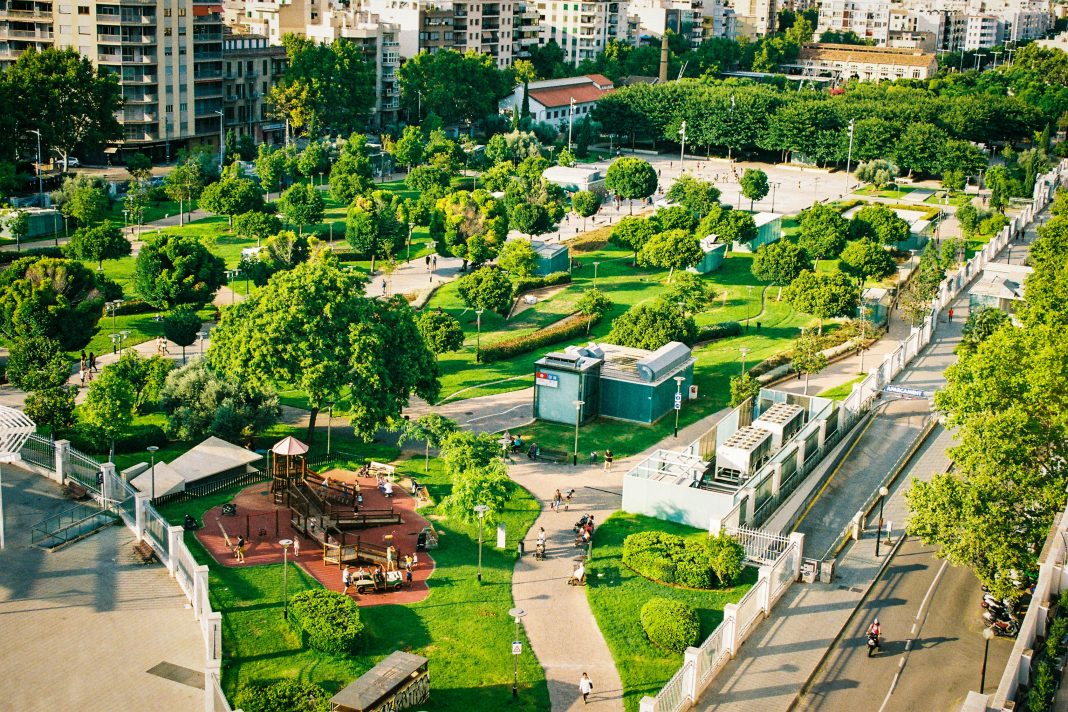Everyone wants some sort of a green nook in their city. A place to relax, cool down and simply enjoy the fresh air. Perfectly fine, but the problem occurs when cities are too dense, over-saturated with cars, and over-polluted with concrete and greyness. This is where strategic planning can help – learn how to go about it, as advised by sustainable urbanisation specialist Marian Stuiver.
Marian Stuiver is a specialist in sustainable urbanisation, green growth and inclusive development. She works as the Programme Leader of Green Cities at Wageningen University & Research in the Netherlands. Green Cities is a programme that focuses on understanding and applying a nature-based approach in urban areas. It aims to make cities climate-adaptive and circular.
Marian shared with us some insightful information on how to properly include green spaces into cities’ strategic planning; what follows are the main takeaways.
Blue-Green Areas
It’s essential for cities to have good blue-green areas. Blue infrastructure refers to water elements (rivers, canals, ponds, etc.), while green infrastructure refers to greenery (trees, lawns, parks, etc.). City planners recognise the importance of establishing proper blue-green areas to allow animals, plants, water, clean air, etc. to move safely around the landscape. However, not just any old implementation will do – it needs to be done correctly. For example, if it’s raining, the water needs to be able to find its way into the soil without accumulating in the neighbourhood. Moreover, any green space can technically be called a ‘park’, but it might not be very interesting for wild animals. If it’s built more in a way that resembles the original vegetation of the area, it becomes more attractive for the wildlife to come back and create a life there.
Ideally, one way of creating more green areas would be to reduce parking lots and plant vegetation instead. Realistically, this will be met with resistance – nobody likes changes very much. If this is the case, go into a negotiation and provide an alternative to car users. Convince them of the benefits: more social space, areas for children to play, a safe place to walk or hang around.
“It’s not only implementing green space, but also involving the community and those that are in favour of it, and creating the social cohesion needed in the community to have this green space. It’s certainly not an easy task,” Marian points out. But it can be done. Green City Accord, for example, is a movement of European cities committed to becoming cleaner and healthier to improve the quality of life of all Europeans. So far, 55 cities from all over Europe have signed the Accord; once signed, they are required to follow a list of mandatory indicators for reporting to truly ensure environmental improvement in these cities.
Enough Greenery for Everyone
World Health Organisation recommends providence of at least 9m2 of accessible, safe and functional urban green space for each person in the city, or ideally 50m2 per person. The current situation in Europe looks mixed, yet promising, as Northern countries are mostly painted green (meaning green spaces are covering 20m2 or more per inhabitants), while Southern are still more on the downside (moving between less than 4m2 and 9m2) – this interactive map provides a more detailed overview.
In practice, this is how this looks like: according to an article by The Telegraph, Singapore is working towards realizing its long-term vision of becoming the City in a Garden, meaning they equally emphasize the importance of green spaces as with other commercial buildings. Since 1967, their urban planners have been promoting biodiversity, leading to a decision that all new developments must include some sort of vegetation (e.g. green roofs). Now, the city is full of parks, tropical nature reserves, botanical gardens, and even aims to become the world’s greenest city.
How to Green Your City
Ok, now that we understand the fundamentals of environmental areas in cities, we need to put the ideas into motion and start working on strategic planning. Here’s how:
Research the Current Projects
If you want to do something on the city level, first you have to look at what’s already happening. Next, you need a framework in which you evaluate what green spaces even are. According to EPA, green space is “land that is partly or completely covered with grass, trees, shrubs, or other vegetation, [including] parks, community gardens and cemeteries.”
Include the Whole Network
After you’ve evaluated and established the criteria, it’s best if they are supported by the people in your city. From community organisations, NGOs, and local leaders, to citizens themselves. Gather them and ask:
- What do you consider a green city?
- For what purposes would you use green spaces?
- What do you think is important to do for the next green space?
- What are we already doing?
- What’s good, what’s working?
- What could we do in the coming years? What are our visions and dreams?
- How can we work on it in small steps?
- Do we need funding? Where are we going to get it from?
- How are we going to incite energy, enthusiasm and passion?
- Which type of ambassadors do we need?
- What kind of knowledge and information can we find on the topic?
Ask yourselves and the people involved these questions, but don’t stray – always go back to the scale that you’re working on. “Make it practical, have short term success, celebrate the success and go on,” points out Marian.
Plan and Set a Framework
WHO advises any visionary to create a planning context: create a long-term vision within the local authority, integrate green space infrastructure needs into urban masterplans, consider retrofitting, etc. Take advantage of the infrastructure already established.
Step Into Action
Gather people that matter in the city, that have a green heart, that dare to innovate, and design a process with them. Take some risks. Find good stories, stories of success that will convince and motivate people.
One example of a success story comes from London, where a certain number of individuals managed to implement a green roof policy into the London Plan. Like with many great things, the process takes time. First campaigning, then writing the policy, then waiting for it to be approved – no matter the time span, it only proves it can be done. Driving changes is a marathon, not a sprint.
Small Steps
Start small – start with a simple park or a community garden. Or get rid of some parking spaces that not everybody will miss and/or get angry over (try to avoid conflicts, at least in the early stages of the action).
“If you want to get close to the people, start small, but have a bigger vision, look at the complexity, but don’t make it too complex for the people that actually live in the street or live in a flat.”
Motivate People
Be creative, innovative. Try to include and make people enthusiastic through various activities. For example, the Netherlands held a national competition between Amsterdam and Rotterdam on who could remove the most tiles in the city and create more green spaces. It was Rotterdam that claimed the victory, with a total of 47,942 tiles removed; however, the real winner is the whole country, encouraging their municipalities to actualise more green areas.

The Future Looks Bright (and Green)
When talking about the improvement of green areas in cities in the future, Marian agreed with us that there is a rising number of green spaces. Especially since the impact of COVID-19 showed us our need for the great outdoors, having a walk in nature and enjoying the fresh air.
Cities are changing the way we coexist with nature, particularly larger cities with a lot of networks on the governmental level, with a lot of larger companies, and with citizens wanting vegetation in their neighbourhoods. And smaller cities are starting to follow the example. In fact, in 2020, Vienna (Austria) claimed the #1 spot of the top 10 greenest cities in the world.
Unfortunately, the social-economic situation in Europe plays a huge part in prioritising the want for greenery:
“If people have a lot of other challenges, social-economic issues, unemployment, health troubles, maybe nature and greenery are not the first thing they think about,”
explains Marian.
“But the fact is that people still want to go to the city to get jobs, and they also want a good environment to live in,” suggests Marian. Creating more green spaces is definitely on the agenda of city planning, even though it could be higher up, “because we do have a pressing, urgent situation with climate change and biodiversity loss,” adds Marian.
Green Strategic Planning in a Nutshell
Repainting grey areas into green ones won’t be easy, but it doesn’t mean it’s impossible. Following these guidelines, we hope to simplify your journey towards a greener city.
To recap: learn about the ongoing projects, define what you want to achieve, don’t get too overwhelmed, and don’t lose hope – stay encouraged and encourage others, be the motivator to successfully accomplish the desired task. And when you one day look back, you will be proud of the green areas you’ve helped to establish.



[…] being said, there is a recommended ‘structure’ you could follow if wanting to add vegetation into strategic […]